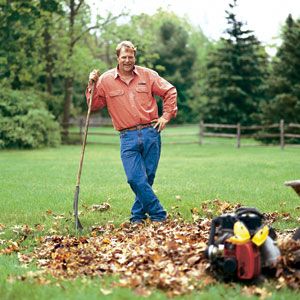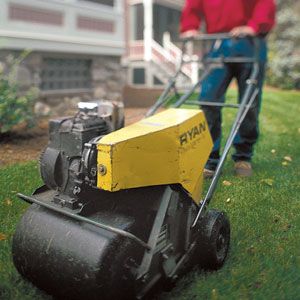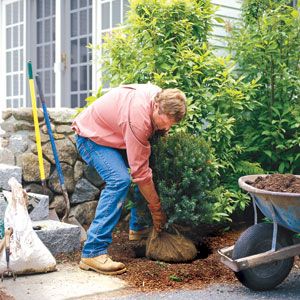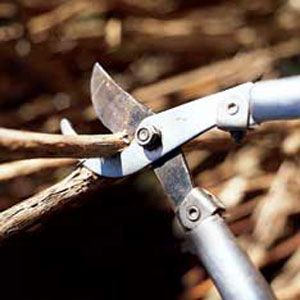
“I don’t know why people don’t do more yard work in September,” says This Old House landscape contractor Roger Cook. “Fall is the absolute best time to get things done, and it gives you a head start on spring.” For most of the country, autumn’s moderate temperatures and plentiful rainfall offer the year’s best gardening conditions. What’s more, many plants are in a phase of intense root growth, which makes fall a great time to plant, transplant, and feed them. So when the first hint of cool air sweeps through your yard — from late August to early October, depending on your latitude and altitude—here’s what you can do to dress up your landscape and lay the groundwork for a lush lawn and beautiful flower beds come spring.
Lawns
“To grow a lawn that greens up naturally each spring and that resists drought and disease, you need to foster a strong root system,” says Roger. This requires annual maintenance — best done in the fall when weeds aren’t likely to sprout.
AERATE: Constant trampling by people, pets, and lawn mowers compacts the soil beneath lawns and prevents air, moisture, and nutrients from penetrating to the roots. If water puddles on top of the turf after a rain, it’s time to aerate. For a small lawn, use a garden fork to punch holes in the soil every few inches. To treat a larger area, rent a walk-behind aerator at your local garden center. (You can save money by splitting the rental costs with a neighbor.) These gas-powered machines have hollow teeth mounted underneath that pierce the turf and pull up small plugs of earth as they roll along. To protect sprinkler heads, be sure to mark and avoid them. Afterward, use a flat shovel to flick a light coating of a sand-and-compost mix over the turf; it will settle into the holes and help improve drainage further.
FEED: After the weekly mowings necessitated by summer”s speedy growing cycle, fall’s slower growth rates can be a relief. But there”s still lots of activity going on underground. “Grass roots keep on growing until the ground gets down to around 40 degrees,” says Roger, “so this is a good time to nourish them.” Use a spreader to apply fertilizer to the lawn, once at the beginning of the fall season and again just before the first frost. Roger prefers a high-phosphorus mix, like 12-25-12 (the three numbers denote, in order, the ratio of nitrogen, phosphorus, and potassium in the fertilizer). This mix stimulates root growth rather than greenery.
SEED: Planting new areas, reseeding bare patches, and overseeding sparse ones now gives the grass a chance to establish itself without having to compete with weeds, which tend to germinate in the spring. Roger suggests not buying the cheapest grass seed at the nursery. Instead, look for one that contains less than 0.5 percent weed seed and comprises a mix of several different grass types and named varieties (e.g., “Alene” Kentucky bluegrass or “Wizard” perennial ryegrass). “That way, if disease affects one, you”ll still have a good-looking lawn,” he says. Also, check the label to see that the seed was harvested no earlier than the previous year. Before sowing, loosen the soil to a depth of 4 to 6 inches with a small tiller or spade and add a lime fertilizer. Then, after seeding, scratch the planting area with a rake to ensure that the seed will come into contact with earth. Water daily.

Trees and Shrubs
Cooler temperatures are perfect for planting or trans-planting large specimens because roots settle in without getting parched. Fall is also an ideal time for pruning some of the trees and shrubs in your yard.
PLANT AND TRANSPLANT: “Like grass, most trees and shrubs stop producing leaves by the end of summer and instead direct their energy toward developing roots,” says Roger. So specimens planted in the fall begin establishing themselves as soon as they”re in the ground. Plus, autumn”s moderate temperatures and moisture levels won”t harm roots temporarily residing in burlap or plastic pots. Complete all planting, particularly where the snow flies, by the middle of October. Later in the fall, you can protect new evergreen plantings from their first dry, cold season by coating the leaves with an anti-desiccant spray, a waxy coating that limits evaporation and locks in moisture. (Such sprays can be harmful to some plants, including arborvitae and blue spruce; check the product label for a list of recommended applications.) If wind or heavy snow is a problem, wrap small trees and shrubs in several layers of burlap or shelter them under a simple plywood lean-to.
PRUNE: Autumn is a good time to prune deciduous trees because you can see the limb structure clearly once the leaves are gone. Concentrate on removing crossing or rubbing branches and suckers, which rob healthy limbs of nutrients, and dead branches, which increase the risk of wind damage. (If you have a hard time spotting dead branches when everything is bare, lightly scratch them to see if they are green.) Some trees, such as maples and birches, have sap that bleeds heavily in the spring, so pruning them in the fall is both healthier for the tree and neater for your tools. You can also safely prune summer-flowering shrubs like rose-of-Sharon, mimosa, and summersweet because they don”t form next season”s buds until the following spring.
FEED AND WATER: Unlike lawn food, tree and shrub fertilizer needs time to break down before it can be completely absorbed. “You want a balanced slow-release fertilizer that feeds the roots throughout the fall and is still around to fuel the stems and leaves next spring,” says Roger. (The exact fertilizer ratio depends on where you live and whether the specimens are deciduous or evergreen; ask your local nursery or gardening club for recommendations.) To help fertilizer reach the roots of large trees, Roger uses a crowbar to punch a 12 to 16-inch-deep hole every 2 to 3 feet outside the tree”s drip line — the outer edge of the canopy, which mirrors the circumference of the roots. Follow the formula printed on the bag to determine the appropriate amount of fertilizer, then mix the food with a few shovelfuls of sand or pea gravel and use the mixture to fill the holes. In late fall, after the leaves have all fallen, top dress around trees and shrubs with more fertilizer, and water thoroughly; this will help sustain them through the winter. When you”re finished, remember to drain the hose, bring it inside, and pack it away.

Annuals and Perenials
Perennials planted in early fall have time to take root before the first frost hits. And there are plenty of cool-hardy annuals that can be put in flower beds to create a striking autumn show.
CLEAN UP BEDS: Spent annuals like marigolds and geraniums should be pulled from their beds, while most perennials that have finished blooming — including black-eyed Susans, purple coneflowers, and astilbe — should be cut back to the ground. This gives the landscape a neater appearance, saves you the trouble of pruning in the slushy spring, and allows the plants to focus their energy on root growth. “But I leave certain plants unpruned to provide visual interest for winter,” says Roger. “Perovskia, sedum, and plumey ornamental grasses look interesting when they get some ice or snow on them.”
PLANT: Since most homeowners buy their plants in the spring, fall shopping means that nursery staff will have more time to assist you and that deliveries will happen quickly. “Nurseries dig up fresh stock in the fall,” says Roger, so there should be plenty of healthy full-priced plants to choose from, including fall varieties of annuals like dianthus, snapdragons, poinsettias, calendula, and ornamental cabbage. You may also find discount prices on some plants, but be wary. “I would inspect anything that”s on sale to make sure it”s healthy and strong and that next year”s buds are set,” says Roger. (Many stores, incidentally, don”t provide a warranty for marked-down items.) After putting in the plants, feed them with a balanced fertilizer containing mycorrhizal fungi, which help roots absorb nutrients. Then mulch over the roots with compost, finely ground pine bark, or ground leaves to protect them from frost, which can pop new plants right out of the ground.
PUT IN SPRING BULBS: Crocuses, daffodils, tulips, and other traditional harbingers of spring must be planted in the fall because they need winter”s chill to trigger their growth. Many bulbs come in early, middle, and late-blooming varieties, says Roger. “So rather than buying a hundred of one kind, buy 30 of each, and you”ll get six weeks of flowers instead of just two.” Note that each type of bulb must be planted at a specific depth. After digging a hole, fill the bottom with a mixture of soil and a small amount of 5-10-5 or 10-6-4 fertilizer — too much can burn the roots. Then set the bulbs in place, cover with more soil, and plant over with fall annuals. Come spring, photograph the bulbs in flower, so you”ll know what color bulbs to add and where to place them when planting the garden next fall.

What to Do With Leaves
Perhaps one reason so few people garden during the fall is that they’re saving their energy for the big leaf cleanup. It’s a laborious job that”s guaranteed to cause a few blisters and possibly even a neighborhood contest to see who can wait the longest to rake their lawn.
“Unless you’ve got a heavy-duty blower, the easiest way to collect leaves is to rake them onto a big plastic tarp,” says Roger. “Then you can drag them wherever they need to go.” Once they”re gathered, don”t throw them away — leaves can be a cheap source of nutrients for your plants if you turn them into compost, or can serve as a simple mulch if you chop them up. If your town distributes biodegradable leaf-collection bags, it probably has a municipal composting program; the town will compost your leaves for you and offer a small amount of free compost come spring. Or you can compost the leaves yourself. Start by placing them inside a container (a simple cylinder made from wire fencing works fine). Turn the mixture regularly — at least once every few weeks — and in less than a year, the compost will be ready to feed the landscape.
For instant gratification, you can turn the leaves into mulch instead. Break up the leaves a bit with a mulching lawn mower, mower attachment, or leaf grinder before spreading them — whole leaves will stick together and smother the lawn. Not only is this faster than composting, but it”ll save you money otherwise spent on commercially available mulches like shredded pine bark or cedar chips. Sprinkle the mulch on top of the lawn or put down a 2 to 3-inch layer in planting beds to protect them from the cold.
If neither option is appealing, Roger suggests an even lazier alternative. “At the end of the season, cut your lawn as short as you can without scalping it. That way, the leaves will have nothing to stick to, and they”ll blow into your neighbor”s yard,” he says with a laugh.
